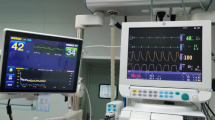Abstract
Background
In the search for the ideal intravenous induction drug, etomidate is in the forefront as it provides haemodynamic stability without compromising on the end point of induction. It has been established that slowing the rate of infusion of propofol decreases the dose required for induction. Even though etomidate provides good haemodynamic stability while inducing, there is concern about its cortisol suppressive function. This study has been designed, with entropy guidance, to establish whether induction by slowing the rate of infusion of etomidate will reduce the dose required for induction and simultaneously assess whether adverse effects are reduced.
Methods
Ninety-six patients were randomly allocated into three groups based on etomidate dose. Etomidate dose was given till both loss of eyelash reflex and entropy50 was achieved. Total dose of etomidate consumed, time taken for loss of eye lash reflex and time to reach entropy50 were recorded. Cortisol levels were measured at different intervals.
Results
We observed that slowing the rate of infusion reduced the dose of etomidate for induction; however, it prolonged the time for induction of anaesthesia. Cortisol levels were suppressed in the first 6 h after induction in all three groups, but remained within normal limits and reached to pre induction levels by 24 h.
Conclusion
The slower the rate of infusion, the lesser the dose of etomidate used for induction, but prolongs the time taken to reach the end point of induction. Incidence of myoclonus might be avoided by infusing etomidate for induction at a lower rate.
Clinical trial number and registry URL
Clinical Trials Registry of India, CTRI/2016/04/006879, www.ctri.nic.in/

Similar content being viewed by others
References
Reves JG, Glass PS, Lubarsky DA, McEvoy MD, Martinez-Ruis R (2009) Intravenous anaesthetics. In: Miller R, Eriksson LI (eds) Miller’s anesthesia, 7th edn. Churchill Livingstone Elsevier, New York, pp 719–740
Yoon SH (2012) Concerns of the anesthesiologist: anesthetic induction in severe sepsis or septic shock patients. Korean J Anesthesiol 63(1):3–10
Erdoes G, Basciani RM, Eberle B (2014) Etomidate--a review of robust evidence for its use in various clinical scenarios. Acta Anaesthesiol Scand 58(4):380–389
Forman SA (2011) Clinical and molecular pharmacology of etomidate. Anesthesiology 114(3):695–707
Peacock JE, Lewis RP, Reilly CS, Nimmo WS (1990) Effect of different rates of infusion of propofol for induction of anaesthesia in elderly patients. Br J Anaesth 65(3):346–352
Möller Petrun A, Kamenik M (2013) Bispectral index-guided induction of general anaesthesia in patients undergoing major abdominal surgery using propofol or etomidate: a double-blind, randomized, clinical trial. Br J Anaesth 110(3):388–396
Berthoud MC, McLaughlan GA, Broome IJ, Henderson PD, Peacock JE, Reilly CS (1993) Comparison of infusion rates of three i.v. anaesthetic agents for induction in elderly patients. Br J Anaesth 70(4):423–427
Kaul TK, Gautam PI, Navneet N, Jagdeep KB (2002) Effects of different rates of infusion of 1% and 2% propofol for induction of anaesthesia in elderly patients. IJA 46(6):460–464
Sinha P, Koshy T (2007) Monitoring devices for measuring the depth of anaesthesia - an overview. Indian J Anaesth 51(5):365–365
Ewalenko P, Deloof T, Landreau MH, Vandesteene A, Reinhold H (1981) Etomidate infusion for laryngoscopy. Acta Anaesthesiol Belg 32(3):185–193
Bruder EA, Ball IM, Ridi S, Pickett W, Hohl C (2015) Single induction dose of etomidate versus other induction agents for endotracheal intubation in critically ill patients. Cochrane Database Syst Rev (1):CD010225
Schenarts CL, Burton JH, Riker RR (2001) Adrenocortical dysfunction following etomidate induction in emergency department patients. Acad Emerg Med 8(1):1–7
Fragen RJ, Shanks CA, Molteni A, Avram MJ (1984) Effects of etomidate on hormonal responses to surgical stress. Anesthesiology 61(6):652–656
Schulte HM, Benker G, Reinwein D, Sippell WG, Allolio B (1990) Infusion of low dose etomidate: correction of hypercortisolemia in patients with Cushing’s syndrome and dose-response relationship in normal subjects. J Clin Endocrinol Metab 70(5):1426–1430
Do SH, Han SH, Park SH, Kim JH, Hwang JY, Son IS et al (2008) The effect of injection rate on etomidate-induced myoclonus. Korean J Anesthesiol 55(3):305–307
Funding statement
Support was provided solely from institutional sources from the institute in which we are working at present (JIPMER).
Author information
Authors and Affiliations
Contributions
Dr. M. V. S. Satya Prakash and Dr. Rajiv were involved in the entire process, starting from figuring out the concept, materialising the concept, doing the cases, writing the manuscript and preparing for publication. Dr. Sakthi Rajan was involved in fine tuning the concept, writing the manuscript and preparing for publication. Dr. Prashant Shankar Rao was involved in doing the cases and writing the manuscript.
Corresponding author
Ethics declarations
Conflict of interest
The authors declare that they have no conflict of interest.
Ethical approval
All procedures performed in studies involving human participants were in accordance with the ethical standards of the institutional and/or national research committee and with the 1964 Helsinki declaration and its later amendments or comparable ethical standards.
Additional information
Publisher’s note
Springer Nature remains neutral with regard to jurisdictional claims in published maps and institutional affiliations.
Rights and permissions
About this article
Cite this article
Prakash, M.V.S.S., Gnanasekar, R., Sakthirajan, P. et al. A comparative study of two infusion doses of etomidate for induction vs standard induction dose of etomidate. Eur J Clin Pharmacol 75, 889–894 (2019). https://doi.org/10.1007/s00228-019-02681-6
Received:
Accepted:
Published:
Issue Date:
DOI: https://doi.org/10.1007/s00228-019-02681-6




